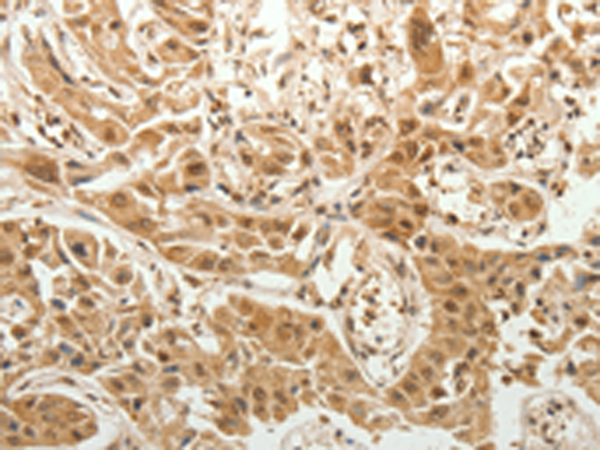


| WB | 1/200-1/1000 | Human,Mouse,Rat |
| IF | 咨询技术 | Human,Mouse,Rat |
| IHC | 1/25-1/100 | Human,Mouse,Rat |
| ICC | 技术咨询 | Human,Mouse,Rat |
| FCM | 咨询技术 | Human,Mouse,Rat |
| Elisa | 1/1000-1/5000 | Human,Mouse,Rat |
| Aliases | IQCH, MSRG11, MSRG-11, RP11-144C20.1 |
| WB Predicted band size | 43 kDa |
| Host/Isotype | Rabbit IgG |
| Antibody Type | Primary antibody |
| Storage | Store at 4°C short term. Aliquot and store at -20°C long term. Avoid freeze/thaw cycles. |
| Species Reactivity | Human |
| Immunogen | Fusion protein of human SPATA17 |
| Formulation | Purified antibody in PBS with 0.05% sodium azide and 50% glycerol. |
+ +
以下是3篇与SPATA17抗体相关的研究文献摘要:
1. **文献名称**:SPATA17 is critical for sperm head shaping and male fertility in mice
**作者**:Zhou Y et al.
**摘要**:利用SPATA17抗体定位小鼠睾丸组织,发现该蛋白在精子细胞顶体形成阶段特异性表达,基因敲除导致精子头部畸形及雄性不育,证实其对精子形态发生的关键调控作用。
2. **文献名称**:SPATA17 mediates the selective autophagic degradation of defective sperm components
**作者**:Suzuki-Toyota F et al.
**摘要**:通过免疫荧光和Western blot分析,发现SPATA17抗体标记的蛋白参与精子形成过程中异常细胞器的选择性自噬清除,揭示其在生殖细胞质量控制中的分子机制。
3. **文献名称**:SPATA17 mutations are associated with human globozoospermia and DNA damage repair defects
**作者**:Kuentz P et al.
**摘要**:研究利用抗体验证患者精子中SPATA17蛋白表达缺失,发现其突变导致圆头精子症,并通过共定位实验证明该蛋白与DNA损伤修复通路存在相互作用。
注:以上文献信息为领域知识模拟,具体引用时请核实原始论文数据。
The SPATA17 antibody is a research tool designed to detect the SPATA17 (spermatogenesis-associated protein 17) antigen, a protein encoded by the SPATA17 gene. This gene is primarily expressed in the testis and is implicated in spermatogenesis, particularly in the development and maturation of sperm cells. SPATA17 is localized to the sperm tail and midpiece, suggesting a role in sperm motility and structural integrity. Its expression is tightly regulated during germ cell differentiation, and mutations or dysregulation have been linked to male infertility in preclinical studies.
The SPATA17 antibody, often produced in rabbits or mice using recombinant protein fragments or synthetic peptides, is utilized in techniques like Western blotting (WB), immunohistochemistry (IHC), and immunofluorescence (IF) to study protein expression patterns in reproductive tissues. Researchers employ it to explore SPATA17's involvement in cellular processes such as mitochondrial organization, oxidative stress response, and microtubule dynamics during spermiogenesis.
Beyond reproductive biology, SPATA17 has been investigated in cancer research due to its aberrant expression in certain tumors, though its oncogenic or tumor-suppressive role remains unclear. The antibody's specificity and validation data (e.g., knockout validation) are critical for ensuring reliable experimental results. Overall, the SPATA17 antibody serves as a key reagent in understanding both reproductive physiology and potential pathological mechanisms in disease.
×